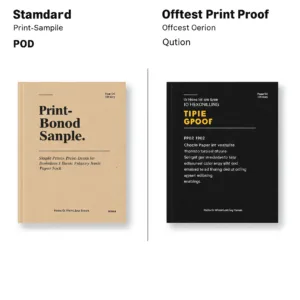Worried that unexpected offset printing delays will sabotage your book launch and marketing plans? Stop guessing and get the realistic timelines you need. This definitive guide breaks down the entire offset process, reveals crucial deadlines, and shows you exactly how to plan effectively to hit your launch date.
Offset book printing typically requires planning 8-12 weeks in advance for standard US domestic production, calculated after final print-ready file approval. However, complex projects involving intricate binding or special finishes, or printing overseas (e.g., Asia), demand significantly longer lead times, often extending to 4-6 months or more due to extended production and shipping durations.
That’s the short answer, but the real key is mastering the variables. Dive deeper to uncover a detailed phase-by-phase breakdown, critical risk factors you must avoid, and actionable planning strategies to ensure your book arrives exactly when needed.
Understanding the Offset Printing Timeframe: Setting Realistic Expectations

First things first, let’s talk about typical timelines. Knowing the general timeframe helps you set realistic expectations from the outset, which is crucial when planning how long in advance you need to print offset books.
Baseline Timelines: What Does “Standard” Really Mean?
Typical Offset Book Printing Timeframes at a Glance
| Scenario / Phase | Estimated Timeframe | Notes |
| Standard Offset (US, post-approval) | 8 – 12 Weeks |
Baseline for typical domestic projects
|
| Complex Offset (US, post-approval) | 10 – 15+ Weeks |
For intricate bindings, finishes, etc.
|
| Overseas Offset (Asia to US, total) | 4 – 6+ Months |
Incl. production, shipping, customs, buffer
|
| Component: Prepress Proofing Cycle | ~1 Week |
Variable based on revisions
|
| Component: Ocean Freight | ~2-3 Months |
Major factor in overseas timelines
|
| Component: Warehouse Buffer | ~1 Month |
Time needed after delivery before on-sale
|
| Print-on-Demand (POD) | ~7-10 Days |
For comparison; much faster turnaround
|
| Rush Offset (US, potential) | ~3-6 Weeks |
Highly variable, costly, check printer
|
When printers talk about a “standard” turnaround for offset printing within the US, they often mean 8 to 12 weeks. It’s vital to remember this clock usually starts after you’ve approved the final print-ready files, not when you first contact them. Naturally, more complex projects take longer.
If your book involves intricate binding, special finishes like foil stamping or embossing, a high page count, or extensive color work, you should realistically budget 10 to 15 weeks, or potentially more.
Planning to print overseas, perhaps in Asia, to manage costs? Be prepared for a significantly longer lead time. Factoring in production (often 4-6 weeks), ocean freight (which can easily take 2-3 months), customs clearance, and final delivery to your US warehouse, you should plan for a minimum of 4 to 6 months from final file submission to having books ready for distribution.
The Print-on-Demand (POD) Speed Contrast
It’s helpful to contrast this with Print-on-Demand (POD) services, understanding the difference between Offset vs POD printing methods is key to choosing the right fit. POD can often turn a file into a printed book within 7 to 10 days, sometimes even faster.
This speed makes POD excellent for certain applications like advance reader copies (ARCs), testing market demand, or managing backlist titles with unpredictable sales.
However, offset printing is typically chosen for the benefits of printing books in bulk (usually 500-1000+ copies) and specific quality characteristics, making its longer, more complex book production schedule a necessary factor to manage.
Rush Orders: Faster Turnaround at a Cost
Need your books faster than the standard timeline? Many offset printers do offer rush services. While this can potentially shorten the turnaround time (perhaps to 3-6 weeks domestically, though highly variable), it’s not a magic bullet.
Rush orders come with significant additional costs and are entirely dependent on the printer’s current workload and capacity. Always discuss feasibility and pricing upfront if you’re considering this route.
Deconstructing the Offset Timeline: Why Does It Take So Long?
Okay, so we know offset printing takes weeks or months, but why? Understanding the distinct phases involved helps clarify where time is spent and where potential delays can occur in your book printing timeline.
Phase 1: Prepress Preparation (Often Underestimated)

Before ink even hits paper, a lot needs to happen. This prepress stage is critical and often takes longer than anticipated.
- File Submission & Review: ou send your print-ready files—learning how to prepare your book files for printing correctly is crucial here—and the printer meticulously checks them for technical issues like correct resolution, bleed settings, and color profiles.
- Proofing: You’ll review proofs to ensure everything is perfect. Electronic proofs (PDFs) are usually quick, potentially delivered within about 8 hours, but allow time for your review. If you need physical hard copy proofs, expect them the next day plus shipping time.Remember, any back-and-forth for corrections adds days, sometimes stretching this proofing cycle to a week or more.
Insight Alert: Submitting perfect, technically sound files is paramount. Files with errors often get pulled from the production queue, causing delays far exceeding the time needed just to fix the mistake. Printers prioritize jobs that run smoothly. - Plate Making: Once proofs are approved, the printer creates the physical metal plates that transfer the ink to paper. Crucial Consideration: Don’t forget the time before you even submit files! Final editing passes, proofreading, design tweaks – these internal steps can easily add an unexpected 2 weeks to 2 months to your schedule, especially for first-time authors. Factor this into your overall plan.
Phase 2: Production (Printing, Binding, Finishing)

This is where the physical creation happens.
- Printing: The actual time on the printing press depends heavily on your order quantity. A run of over 10,000 copies will naturally take several weeks or longer just for printing, compared to smaller runs.
- Drying Time: Offset inks need time to cure properly to prevent smudging. This can take hours or even days, depending on the ink type, the paper stock (coated and thicker papers take longer), and environmental factors like humidity.
- Binding & Finishing: After printing, pages are folded, collated, and bound. More complex binding like hardcover takes longer than paperback. Additional finishing steps like lamination, UV coating, die-cutting (which requires making a die, adding about 5 days itself), or foil stamping are some of the special printing processes that add aesthetic value but also require 1-2 days or more each.
Phase 3: Shipping & Logistics (The Final Hurdle)

Your books are printed, but they still need to get to you or your distributor.
- Transit Time: Within the US, ground shipping might take 1-2 weeks. If printing overseas (e.g., Asia), you’ll need to factor in ocean freight, which is common when you Ship books from China and can take 4-8 weeks or significantly longer, plus time for customs clearance.
- Warehouse & Distribution: Plan for buffer time after delivery. Warehouses need time (often around 1 month) to receive inventory, process it, and prepare it for distribution to retailers or end customers before your official on-sale date.
Self-Publisher Note: With an offset run, you are responsible for arranging and paying for storage and coordinating fulfillment – key aspects covered in resources about managing the self-publishing process – which shouldn’t be overlooked.
Key Factors Influencing Your Offset Printing Timeline
While we’ve outlined typical phases, several variables can significantly stretch or (less commonly) shorten your specific printing lead time. Understanding these helps you plan more accurately and identify potential risks.
Project Specifications
The details of your book project itself play a huge role:
- Quantity: As mentioned, printing 10,000 books simply takes longer on press than printing 1,000.
- Complexity: High page counts, multi-color printing throughout, intricate designs, or included elements like fold-outs naturally extend production time.
- Binding: A complex hardcover binding with a dust jacket will require more steps and time than a standard perfect-bound softcover.
- Paper Stock: Choosing a readily available standard stock is generally faster. Opting for specialty paper might involve longer sourcing times, especially if there are paper stock availability issues, which have been a known challenge. The paper type also impacts drying time.
Printer Variables
Factors specific to the printing company also matter:
- Current Workload: A printer running at full capacity will have a longer queue and less flexibility than one with open press time. It’s always wise to ask about their current schedule.
- Printer Specialization: Some printers are optimized for certain types of jobs (e.g., high-volume paperbacks vs. short-run art books) and might be more efficient for projects matching their specialty. Insight Alert: Building a good working relationship with your printer can sometimes be beneficial. While not guaranteed, printers may prioritize loyal, reliable clients, potentially offering better scheduling insights or flexibility during busy periods compared to one-off jobs purely focused on the lowest price.
External Factors (The Unpredictables)
Some factors are largely outside your or the printer’s direct control but must be considered:
- Supply Chain Issues: As highlighted by industry experts, disruptions in paper supply, ink availability, or transportation logistics can cause unexpected delays. These have notably impacted offset printing timelines globally in recent years.
- Peak Seasons: Demand for printing surges during certain times. Be prepared for potentially longer lead times and book capacity well in advance if targeting major US holiday season deadlines like Thanksgiving, Black Friday, or Christmas, or other busy periods like the back-to-school season (Solution Framework). Planning months further ahead for these periods is essential.
Your Action Plan: Mastering the Timeline & Protecting Your Launch

Knowing the timelines and potential pitfalls is one thing; actively managing them is another. Here’s a practical, step-by-step approach to take control of your offset book printing schedule and ensure it supports, rather than hinders, your marketing efforts.
Step 1: Implement Detailed Reverse Timeline Planning
This is arguably the most critical step. Don’t just guess – calculate!
- Start at the End: Identify your absolute must-have date. This might be your official on-sale date, a major event like a book fair, or the date books need to be in stores for a seasonal promotion (like Holiday season deadlines).
- Work Backwards: From that end date, subtract realistic time blocks for each preceding phase:
- Warehouse/Distribution buffer (~1 month)
- Shipping (factor in domestic vs. overseas)
- Full Production (printing, drying, binding, finishing – get estimates based on your specs)
- Prepress (proofing cycles, plate making – allow at least 1-2 weeks)
- Crucial: Internal Content Finalization (final edits, proofreading, design approval – be honest about how long this takes your team or you).
- Add Buffer Time: Life happens! Build in a contingency buffer for unexpected delays. A common recommendation is adding at least 20% to your estimated production/shipping time, or a minimum of 3-4 weeks buffer overall.
- Visualize It: Use a simple spreadsheet, calendar, or a project management tool to map this out. Seeing the deadlines visually makes the timeline tangible and helps track progress. This detailed reverse plan becomes your roadmap, highlighting your true “files-to-printer” deadline.
Step 2: Proactive Risk Management & Contingency Planning
Assume that delays might happen and plan accordingly.
- Identify Potential Risks: Think about what could go wrong based on your project and printer (e.g., complex design prone to file errors, reliance on potentially scarce paper stock, shipping during peak season, working with a new printer).
- Mitigate What You Can:
- Flawless File Prep: Use your printer’s checklist meticulously. Double, triple-check files before submitting to avoid getting bounced from the queue.
- Early & Clear Communication: Talk to your printer early about their capacity, confirm paper availability, and ask about potential bottlenecks. Cultivating a good relationship might offer slight advantages in communication or flexibility.
- Confirm Everything: Don’t assume; get key dates and confirmations in writing.
- Have Backup Plans: What will you do if there’s a significant delay? Could you use digital printing for a small, urgent batch? Can marketing efforts be shifted? Have alternative content or promotions ready.
Step 3: Synchronize Printing Milestones with Marketing Cadence
Your printing schedule and marketing plan must talk to each other.
- Map Key Dates: Determine when marketing needs things from production:
- Final Cover Reveal: You’ll need the finalized cover design potentially months before the print files are due, especially if printing overseas.
- Advance Reader Copies (ARCs): If sending physical ARCs, factor in their separate print and shipping time.
- Pre-Orders: Ensure your delivery date allows enough time to fulfill pre-orders promptly after the book arrives.
- Launch Events/Promotions: Schedule these after you have confirmed book delivery, plus a safety buffer. Don’t book venues or ad spend based on optimistic estimates. Example: Planning a big push for Black Friday sales (late November)? For a domestic US offset run, you’d want books arriving by early November. Working backward with an 8-12 week production + buffer, you’d need to send final, approved files to your printer no later than June or July.
If printing overseas, that file deadline could easily be March or April! Aligning these timelines prevents wasting marketing resources and disappointing your audience.
Conclusion: Master Your Offset Printing Timeline
Successfully navigating offset book printing hinges on long-range planning—think months ahead, not weeks. Understand the production phases, proactively manage potential risks, and tightly synchronize your print schedule with your marketing activities.
By planning backward, adding generous buffer time, communicating clearly with your printer, considering the Total Cost of Ownership, and choosing your printing methods wisely, you take control of your offset printing timeline and ensure your book arrives ready for a successful launch. Knowing how long in advance you need to print offset books is the first step to mastering the process.







